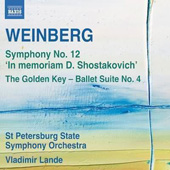

Once you get passed the rather bellicose, stubborn, in-your-face, but surprisingly uninspired and overdrawn first movement, the Symphony No. 12 'In memoriam D. Shostakovich' could very
well be considered one of Mieczyslaw Weinberg's finest efforts in the genre, and also one of his most intimate and revelatory symphonies. The impetus behind this 1976 composition was the death the year
before of his close friend and comrade in music, Dmitri Shostakovich. And what makes this dedicatory symphony even better, is the fact that Weinberg avoids the pitfall of overtly making use of typical Shostakovich trademark
gestures, in favor of subtle hints at the man's oeuvre and overall spirit. This is definitely a purebred Weinberg work from start to finish.
Mind you, the opening movement is not a complete washout, as some of the quieter central episodes pull you into their inward looking narrative. It's just that the other three movements have much more to say. The scherzo
for example, which moves along over great strides of propulsive force, reveals some of Weinberg's best counterpoint work and layering effects, clever dynamic shading and rhythmic momentum. Most striking of all, is how
Weinberg holds the tension and slowly manoeuvres the music along in the third movement Adagio, and masterfully brings everything together at the very end to coalesce into a powerful resolution. This is the
movement in which the ghost of Shostakovich seems to lurk behind every note. Listen closely to some of the lower string bass lines, and you can't help but feel a presence. A xylophone (or marimba) abruptly leads the way into
the final movement, reminding us of Shostakovich's sarcastic touches, and everything builds to a few powerful climaxes before, in the end, bringing the whole symphony to an enigmatic and strangely unresolved conclusion.
This recording is the third installment in the ongoing Naxos cycle of Weinberg's symphonic output performed by the St Petersburg State Symphony Orchestra under the direction of
Vladimir Lande. The first two outings, Symphony No. 6 (reviewed here) and Symphony No. 19 (reviewed here),
come highly recommended. All three volumes hold every indication that this could be a Weinberg cycle worth collecting.
Jean-Yves Duperron - February 2014